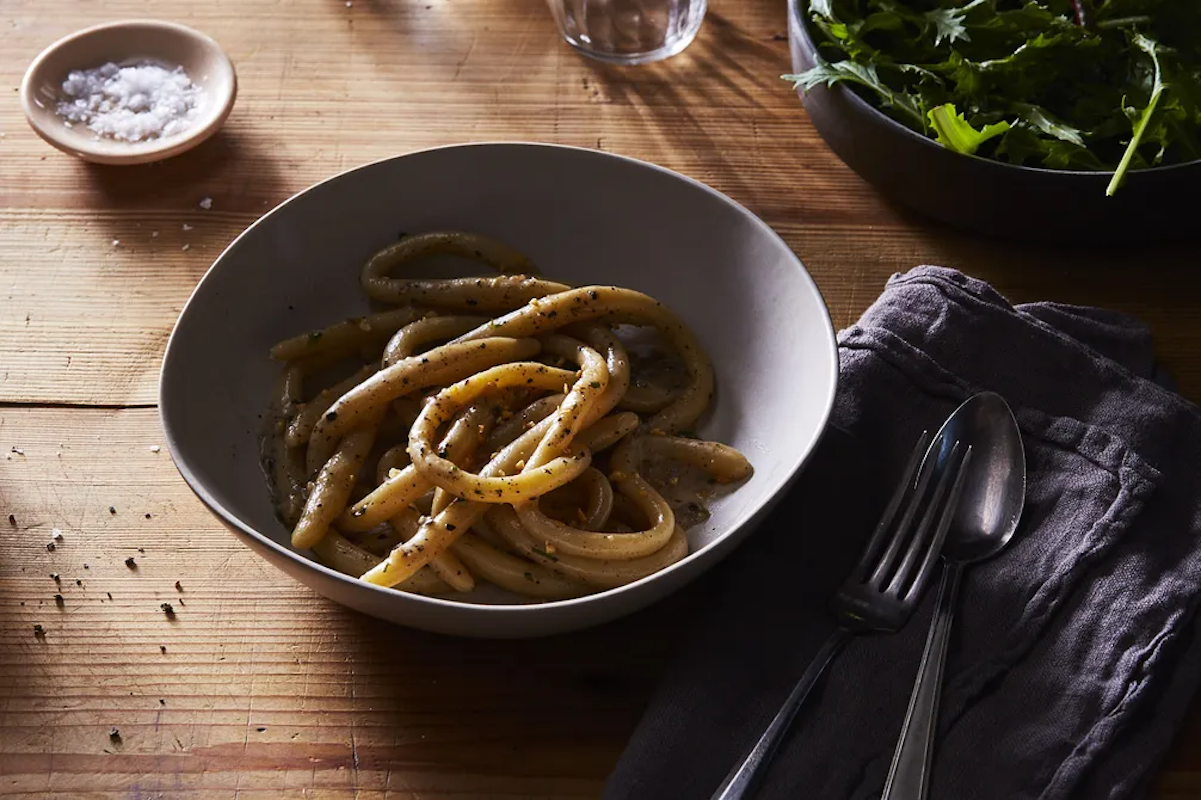Every week we get Down & Dirty, in which we break down our favorite unique seasonal fruits, vegetables, and more.
Today: We’ve been stocking up on fresh herbs to get our spring fix. Next up, marjoram.
Marjoram is like a thumb. (Stay with me here.) Earlier this week, I gave my daughter a preschool level anatomy lesson and explained the names we have for different fingers: thumb, pointer finger, and so on. Then I got cocky and added: “You have one thumb on each hand, and thumbs are fingers, but not all fingers are thumbs.”
My daughter got a little lost, but because you’re not three-and-a-half-years-old, you might already know where I’m going: Marjoram (Origanum majorana) used to belong to its own genus, but now it belongs to the same genus as oregano (Origanum vulgare). This means that all marjoram is now a type of oregano, but just as all fingers are not thumbs, all oregano is not marjoram. It’s an herb that you can find year-round but is mainly in season during the summer, fall, and winter months. It’s known for its sweet, spicy flavor that is mild compared to oregano. But marjoram is its own herb, damn it, and we are finally giving it the spotlight that it deserves.
What does marjoram taste like?
Marjoram looks similar to oregano, which is perhaps not surprising since they are so closely related, but there are differences in flavor. As Deborah Madison explains: “Marjoram’s flavor lacks the oiliness and abrasiveness of oregano. Marjoram is more delicate and floral than oregano. It is sometimes called ‘sweet marjoram’ and for good reason.” Even if you think you’re not familiar with marjoram’s flavor, you’ve likely had it in its dried form. Dried marjoram often shows up in herb blends like za’atar and herbs de Provence.
By comparison, oregano is in season from late fall through early spring and has a more pronounced flavor than marjoram. Italian oregano is milder than Greek oregano, which brings even more of a kick to pizza sauce, grilled pork or chicken, fish, and egg dishes.
How to store and prep marjoram
Store fresh marjoram in the refrigerator: First wrap it in a damp paper towel or tea towel, and then loosely wrap that bundle in plastic wrap or tuck it inside of an airtight container. When you’re ready to cook with your fresh marjoram, separate the leaves from the stems (1, above), and then chop the leaves (2, below) as directed and proceed with your dish.
Start using more marjoram now, but continue to do so as warmer weather arrives, too. We often consider basil, one of marjoram’s relatives in the Mint family, to be the herb of summer, but Deborah Madison pushes us to consider using marjoram in place of basil “with many summer foods, from tomatoes to zucchini to corn.”
Health benefits of marjoram
You should first and foremost consume marjoram because it’s delicious. But it doesn’t hurt that it’s touted for having antimicrobial properties and anti-inflammatory benefits too. In its fresh or dried form, sweet marjoram contains antioxidants, essential oils, and flavonoids associated with fighting free radicals and toxins.
Ready to start using more fresh marjoram? Like other delicate herbs such as sage or mint, fresh marjoram should be added towards the end of the cooking process in order to preserve its vibrant green color and flavor. Heat will cause both qualities to deteriorate over time so unless a recipe specifically calls for adding it early on, there’s no need to do so. Oh and if all you have on hand is dried marjoram, cut the amount by ⅔; dried herbs are always much more potent than fresh so it takes far less to bring flavor.
Marjoram will always pair well with Mediterranean food and is used heavily throughout Italian and Greek cooking. Here are 10 of our favorite foods, and a few delicious recipes, to pair it with:
1. Green Beans
Try: Bean Salad Nicoise or Lemony Green Bean Salad with Feta, Red Onion, and Marjoram
2. Cheese
Try: Torta Pasqualina (Easter Chard and Ricotta Pie) or Baked Ricotta and Goat Cheese with Candied Tomatoes
3. Eggs
Try: Frittata with Asparagus, Spring Greens, and Fontina or Cesare Casella’s Pontormo Salad with Pancetta and Egg
4. Cauliflower
Try: Bacony Cauliflower Gratin or Hippie Pie (with a Bow to Mollie Katzen)
5. Corn
Try: Buttered Corn and Noodles or Fresh Corn Spoon Bread
6. Poultry
Try: Ham-Cured Goose Legs with Butter-Poached Peas and Carrots or Spatchcocked Roast Turkey
7. Pork
Try: Mozzarella, Prosciutto, and Olive Salad Stromboli or Braised Pork Shoulder with Chanterelles
8. Beef
Try: Quick Braised Sirloin with Horseradish Sauce or Truly Tender Meatballs in Rich Tomato Sauce
9. Chili Peppers
Try: Sweet Pickled Chipotles or Grilled Poblano and Potato Frittata
10. Mushrooms
Try: Meg’s Marinated Mushrooms or Braised Chicken and Mushroom Ragu with White Curry Spices


